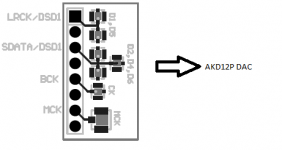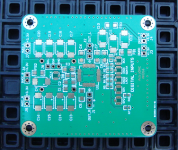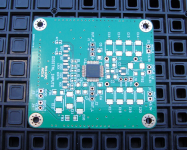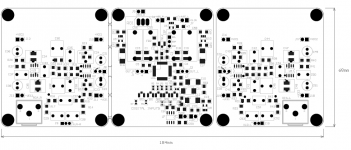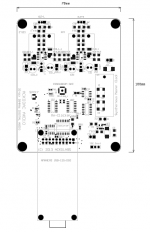On second thought, I realize decoupling is a very bad idea and that I just made a fool out of myself. I don't know what I was thinking 
Regarding the fanout, I figured the data lines should be able to drive 3 inputs if it works correctly with the Buffalo 2, since it internally (as in on the PCB) connects several inputs together. Basically, what I want to do is this and if I understand Dustin correctly here the only way to support I2S/DSD/SPDIF that way is to short D1 to D5 and D2 to D4 to D6 since the internal switching do not cover this. Since I don't want to hack into the ackoDAC PCB I thought I'd do it externally, but really, the result should be the same.
Regarding the fanout, I figured the data lines should be able to drive 3 inputs if it works correctly with the Buffalo 2, since it internally (as in on the PCB) connects several inputs together. Basically, what I want to do is this and if I understand Dustin correctly here the only way to support I2S/DSD/SPDIF that way is to short D1 to D5 and D2 to D4 to D6 since the internal switching do not cover this. Since I don't want to hack into the ackoDAC PCB I thought I'd do it externally, but really, the result should be the same.
fanout
This should work fine. It is the cable capacitance the would affect the drive from WaveIO so keep it as short as possible. Of course each input has its own 'gate' capacitance. Combining inputs (on-board or externally) increases the effective capacitance so a buffer after WaveIO could be useful especially if you are looking forward to dual mono fanout
Regarding the fanout, I figured the data lines should be able to drive 3 inputs if it works correctly with the Buffalo 2, since it internally (as in on the PCB) connects several inputs together. Basically, what I want to do is this and if I understand Dustin correctly here the only way to support I2S/DSD/SPDIF that way is to short D1 to D5 and D2 to D4 to D6 since the internal switching do not cover this. Since I don't want to hack into the ackoDAC PCB I thought I'd do it externally, but really, the result should be the same.
This should work fine. It is the cable capacitance the would affect the drive from WaveIO so keep it as short as possible. Of course each input has its own 'gate' capacitance. Combining inputs (on-board or externally) increases the effective capacitance so a buffer after WaveIO could be useful especially if you are looking forward to dual mono fanout
Last edited:
Remapped Connections I2S/DSD
It is best to used a small adapter with all the w.fl coax connected as shown. Then use a short length of w.fl cable assy from this adapter to DAC
Can be made to match the type of transport used. Shown is for SDTrans384. Others similar. What is your transport?
Edit: LRCK/DSD1 should be LRCK/DSD2
Thanks acko. Should I worry about trace impedance and reflections?
It is best to used a small adapter with all the w.fl coax connected as shown. Then use a short length of w.fl cable assy from this adapter to DAC
Can be made to match the type of transport used. Shown is for SDTrans384. Others similar. What is your transport?
Edit: LRCK/DSD1 should be LRCK/DSD2
Attachments
Last edited:
I'm planning to use the WaveIO (which uses u.fl for I2S), but who knows what the future holds...
The (current) design of my PCB is very similar to your picture, apart from being modular, i.e. 1 input u.fl and footprints for 3 output w.fls per PCB. Maybe I should make it a one PCB solution like yours, as this will be neater and there's no need to connect resistors to ground on unused connector footprints to minimize reflections.
I thought I'd be clever and save money on manufacturing as few PCBs I don't need as possible, but all things considered, maybe it's not such a good idea after all. Also, the additional cost will be quite small considering the cost of the rest of the build
The (current) design of my PCB is very similar to your picture, apart from being modular, i.e. 1 input u.fl and footprints for 3 output w.fls per PCB. Maybe I should make it a one PCB solution like yours, as this will be neater and there's no need to connect resistors to ground on unused connector footprints to minimize reflections.
I thought I'd be clever and save money on manufacturing as few PCBs I don't need as possible, but all things considered, maybe it's not such a good idea after all. Also, the additional cost will be quite small considering the cost of the rest of the build
... Shown is for SDTrans384. ...
Is the board ready to be distributed like Amanero reclocker board?
By the way, have you integrated your turbo clock board with SDTrans?
Is the board ready to be distributed like Amanero reclocker board?
By the way, have you integrated your turbo clock board with SDTrans?
Board shown was for reference only to indicate fan-out to AKD12P module. Prefer to use the Amanero Isolator/Reclocker type board as isolating the SDTrans FPGA is beneficial- plus the re-clocking. Of course, a board to fit the SDTrans nicely can be made for those who are interested-min qty applies.
I will test the Turbo clock unit with SDTrans when the Reclocker boards are ready.
AKD16 Re-release
There has been some updates to this 9016 DAC board. New version has inputs re-mapped for stereo I2S/DSD and 2CH Spdif (TTL). Board layout has been further improved and now with U.FL coax for direct connection to popular transports. Available as bare boards and chip mounted options.
There has been some updates to this 9016 DAC board. New version has inputs re-mapped for stereo I2S/DSD and 2CH Spdif (TTL). Board layout has been further improved and now with U.FL coax for direct connection to popular transports. Available as bare boards and chip mounted options.
Attachments
9016 DAC Combo
Hi,
Some updates of on a complete DAC system based on 9016. This combo board has both DAC and IV cct integrated as shown. Shown panelized with the options to detach IV and re-mount/stack if desired.
DAC side has LDOs for both digital and analog side and can be powered by a single external 5V-12V supply. Analog AVCC has mounting options for 3-term shunt regs or similar.
IV stage requires symmetrical supplies (+/-5-to +/-15V). Both SE and Balanced outputs. Clock and controller are external-TBA. Physical board will be available in ~4wks
Hi,
Some updates of on a complete DAC system based on 9016. This combo board has both DAC and IV cct integrated as shown. Shown panelized with the options to detach IV and re-mount/stack if desired.
DAC side has LDOs for both digital and analog side and can be powered by a single external 5V-12V supply. Analog AVCC has mounting options for 3-term shunt regs or similar.
IV stage requires symmetrical supplies (+/-5-to +/-15V). Both SE and Balanced outputs. Clock and controller are external-TBA. Physical board will be available in ~4wks
Attachments
Hi,
Some updates of on a complete DAC system based on 9016. This combo board has both DAC and IV cct integrated as shown. Shown panelized with the options to detach IV and re-mount/stack if desired.
DAC side has LDOs for both digital and analog side and can be powered by a single external 5V-12V supply. Analog AVCC has mounting options for 3-term shunt regs or similar.
IV stage requires symmetrical supplies (+/-5-to +/-15V). Both SE and Balanced outputs. Clock and controller are external-TBA. Physical board will be available in ~4wks
Hi All,
This design will be updated using the newer chipsets:
ES9018K2M
ES9016K2M
ES9010K2M
Awaiting samples and further information
After going through the details it appears that the original 9016 DAC in 2CH mode is comparable to the new ES9018K2M, losing out a bit on THD figures. Definitely better than the new ES9016K2M counterpart. Also, Spdif on the 2KM series shares with DSD/PCM inputs and needs to be switched in/out
The low cost ES9010K2M chip is superior and more flexible than the 9023.
Most likely a new model AKD10, using ES9018K2M/ES9010K2M will be rolled out.
.... Spdif on the 2KM series shares with DSD/PCM inputs and needs to be switched in/out
Oh, actually there are a couple of spare I/O lines that can be configured for Spdif. So, all good then with the new series
Oh, Amanero Combo384 is perfectly integrated into the DAC!
By the way, would you inform us which frequencies of synchronous master clocks you assume?
Yes, I am trying to see if Zero DPLL_BW lock can be achieved by this tighter integration. Obviously there will be no more interconnect signal/clock cables and capacitance to worry about... Amanero's flexibility makes it the best choice for Full Sync mode but other transports could also be used and inputs will be provided.
Sync frequencies are 98.304/90.3168MHz from possibly a custom build XO module this time for further enhancement.
Digital section will all be fully assembled and tested. Options for power supplies of choice and final build (space permitting) could include on-board controller and digital Volume.
Will it still be compatible with Owen's NTD1?
Output is balanced current or voltage mode. There is an on-board IC IV stage (XLR out) but this could be bypassed with external IV of choice and I believe this will be compatible with NTD1 as used in the big brother 9018 DAC
- Status
- This old topic is closed. If you want to reopen this topic, contact a moderator using the "Report Post" button.
- Home
- Source & Line
- Digital Line Level
- ackoDAC based on ES9018
